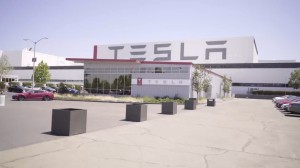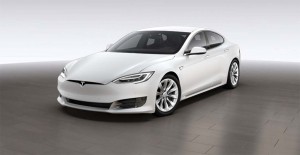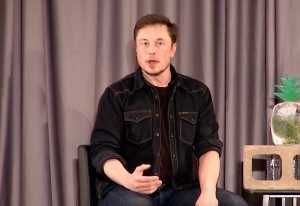
Tesla's new Shanghai plant is expected to be at least as large as its factory in Fremont, California - and include battery production, as well.
(This story has been updated with new information.)
Pres. Donald Trump’s trade war has claimed its first automotive victim, Tesla announcing it will raise prices on some models on sale in China by $20,000 or more to reflect the impact of new tariffs on American-made vehicles.
At the same time, CEO Elon Musk is on his way to China, numerous reports indicating Tesla is set to lock down a deal with authorities in Shanghai to set up the company’s first foreign assembly plant. Musk confirmed construction will begin in about three months and the facility will produce 500,000 vehicles annually once it is ramped up to full production.
Despite the news about tariffs – which could depress sales in the world’s largest battery-car market in the near-term – investors appear to be buoyed by reports that Tesla will move forward on a Chinese assembly plant. Musk has also indicated that the automaker is working on plans to set up a second foreign plant somewhere in Europe.
“Shanghai will be the location for the first Gigafactory outside the United States,” Musk said in a statement. “It will be a state-of-the-art vehicle factory and a role model for sustainability. We hope it will be completed very soon. We’ve been impressed by the beauty and energy of Shanghai and we want our factory to add to that.”
(Why has Wall Street been souring on Tesla? Click Here to find out.)
It is unclear if Tesla CEO Musk has already arrived in China, several news reports conflicting on the timetable for his travel, but Reuters has reported that the automaker’s representatives on Tuesday signed an agreement with officials from that country’s largest city to move ahead on the new plant. It is expected to be located in Pudon, the same region of Shanghai where numerous other automakers, including General Motors, have already established a massive automotive manufacturing center.
Details, including the cost for the new plans, as well as the timetable for putting it into operation, have not yet been released.
(Click Here for more about Tesla meeting its goal of 5,000 Model 3 sedans in one week.)
But Tesla clearly has reason to move as quickly as possible. The carmaker has struggled to gain ground in China, despite that country’s push to electrify its automotive market. And it is expected to face even more difficulties now, as a result of the Trump trade war. China and the U.S. have each imposed new levies on $34 billion worth of goods, American-made autos one of the key targets for the Chinese.
Tesla has become the first U.S. automaker to announce it will raise prices on vehicles sold in that booming market by 20 percent – which would translate into an increase of $20,000 or more on high-line products like the Models S and X. How much that will impact the carmaker’s sales is uncertain, though China accounted for 17% of Tesla’s revenue last year.
The possibility of losing momentum in China – overall, the world’s largest automotive market – has weighed heavily on Tesla investors in recent days, along with other factors that have seen TSLA shares tumble to their lowest level in months. Fully a third of the 31 investors who track the automaker have now issued “Buy” recommendations, a strong sign of concern, another third rating Tesla a “Hold.”
But word that the company will move ahead with a Chinese plant obviating, or at least minimizing, any trade war impact, appears to be buoying nervous investors.

Tesla could use the Shanghai plant now considering it has to raise prices on American-made products like this Model S by as much as $20,000 due to new tariffs.
The big question is how soon such a factory could get up-and-running. It typically takes close to two years to launch a new assembly line at a greenfield site. That could take even longer considering Tesla is expected to aim for annual production capacity of 500,000 vehicles, or roughly twice what the typical automotive plant puts out.
Further complicating matters, when Tesla CEO Musk strongly hinted at plans for a Chinese plant during a May conference call he indicated the factory would integrate a version of the company’s Gigafactory battery plant. That would, in itself, be a tremendous undertaking. Roughly three years after Tesla and battery partner Panasonic began setting up the current Gigafactory in Reno, Nevada it is still not fully up to capacity.
Snags at that Reno plant, in fact, have contributed to the slower-than-planned ramp-up of Model 3 sedan production at Tesla’s Fremont, California assembly plant.
Musk has suggested that a lot of what Tesla has learned about manufacturing will go into the new China plant, helping speed up future production.
Tesla is expected to continue expanding its manufacturing base, and Musk, in May, also indicated he hoped to have news about a European factory before the end of this year.
(EV sales on the rise in the first half of 2018. Click Here for the story.)


Takes 2 years to production and by that time competition will crush Tesla.
Correction, statement from Tesla said it will take 3 years to production. I predict Tesla will file for bankruptcy before the new factory can be completed. May be the Chinese government will come to the rescue in 2020.
Another factory in Europe? You must be dreaming.
That is THEIR stated plan, not mine.
Paul E.
“Donald Trump’s trade war has claimed its first automotive victim…”
Not clear who you think the victim is, Trump, USA, China, Musk?
Make them where you sell them!
Clearly, Dick, you don’t understand globalization and the way it helps maintain an efficient manufacturing system. BMW, for example, produces X utes in Spartanburg because the U.S. is the prime market. But it does not generate enough volume to dedicate that plant solely for the American market and that means a large number of vehicles are exported. By your logic, the plant should downsize and American workers building export vehicles in Spartanburg should lose their jobs. Meanwhile, the cost of those X vehicles would be significantly higher because of lower volume on which to spread fixed costs. Same with the Ford Mustang plant. Export sales have been surging, but you would have the Flat Rock plant become far less efficient and have Ford give up on the U.S. exports.
The irony is that we’ve actually seen a surge of manufacturing COME to the U.S. over the past 30 years, since the first Japanese transplants opened. Japanese makers, in fact, currently import notably less vehicles than they did in the 1980s…but also are among the biggest automotive exporters from the U.S. A sizable share of MB and BMW vehicles are exported. Volvo will be using its new Charleston plant as a global export base.
This is foolish “logic” that WOULD drive up prices, reduce choice and likely result in fewer, not more, American jobs.
Paul E.
The web link shows Model 3 production over the past year. Already over 30,000 produced, Model 3 are likely to reach 100,000 by the end of the next quarter.
As opposed to the original Tesla forecast? And are you basing that on assumption of maintaining or exceeding 5,000/week…which many analysts are skeptical of?
Paul E.
Skeptical of a Tesla claim?? Paul! Where is your faith?? Why, just the other day I was talking with Martin Tripp…